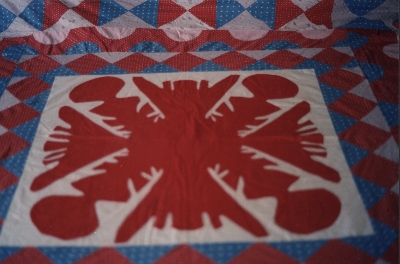Quilt No.386CW - Colleen Whitaker

The quilt top was made on a ship from Ireland in 1840 by Bridget Halloran (born Tully). It was handed on to her daughter Catherine who married William Hansell and then passed by maternal descent to the present owner who is the great great grand-daughter of the maker (fifth generation). It is not used and is stored in a camphor wood box.
The family suggest that the reason the quilt was not finished (backed) may have related to the time available on the ship. If the quilt wasn't finished on arrival there wasn't time in the 'new country'.
"This (the quilt) is believed to have been made on the ship from Ireland in 1840 by Bridget Tully, daughter of Michael and Mary Tully of Ballynakill. Born in the county of Galway in 1816. One of ten children. In 1838 she married Michael Halloran. In 1840 she immigrated to Australia on The Isabella, with her daughter Ellen and sisters and their husbands. She left behind an ailing husband, Michael Halloran who was supposed to join them later.
Patrick Tully, her brother, already in Australia, filled in an appplication form for the Hallorans to immigrate as farm workers, the fare being paid by the N.S.W. Government. In all, nine of the Tully siblings came to settle in the Goulburn district.
She had arrived in Sydney and moved by dray, with her daughter and sister Catherine to Ryansvale, a farm run by the Ryan brothers 12 miles from Goulburn, near Bungonia. In 1841 Bridget gave birth to another daughter called Catherine. She had become sick on the boat. At first they thought she was sea sick but discovered she was pregnant, father being Michael Halloran.
In 1843 she received news through her brother in law Michael Costello that her husband Michael Halloran had died.
In 1849 she married James Clark Armstrong in the Church of England at Bungonia, although she remained a praticing Catholic. Armstrong went off gold prospectring most of the time while Bridget supported her daughters by selling milk and butter from their small farm.
In 1871 Bridget became a widow again when James died at the gold fields of Araluen aged 65 years. She lived the rest of her life with her grandson at Windellama (in the same area). She died in 1902 and is buried at Bungonia."
"This information on Bridget was obtained from writings about the Tully family by James Abbey descendant of Catherine Tully and Alexander Abbey. Bridget's niece Mary Costello married Patrick Durack. Her brother or nephew Patrick and Patrick Durack were mining mates whose family had come from the same part of Ireland to join the large Irish community around Goulburn."
[ Colleen Whitaker, 8.3.1999]
Related Quilts:
2109 X 1727mm
2200 x 1900mm
1370 x 1220mm
2100 x 1950mm
1740 x 1300 mm.
2180 x 1710mm






